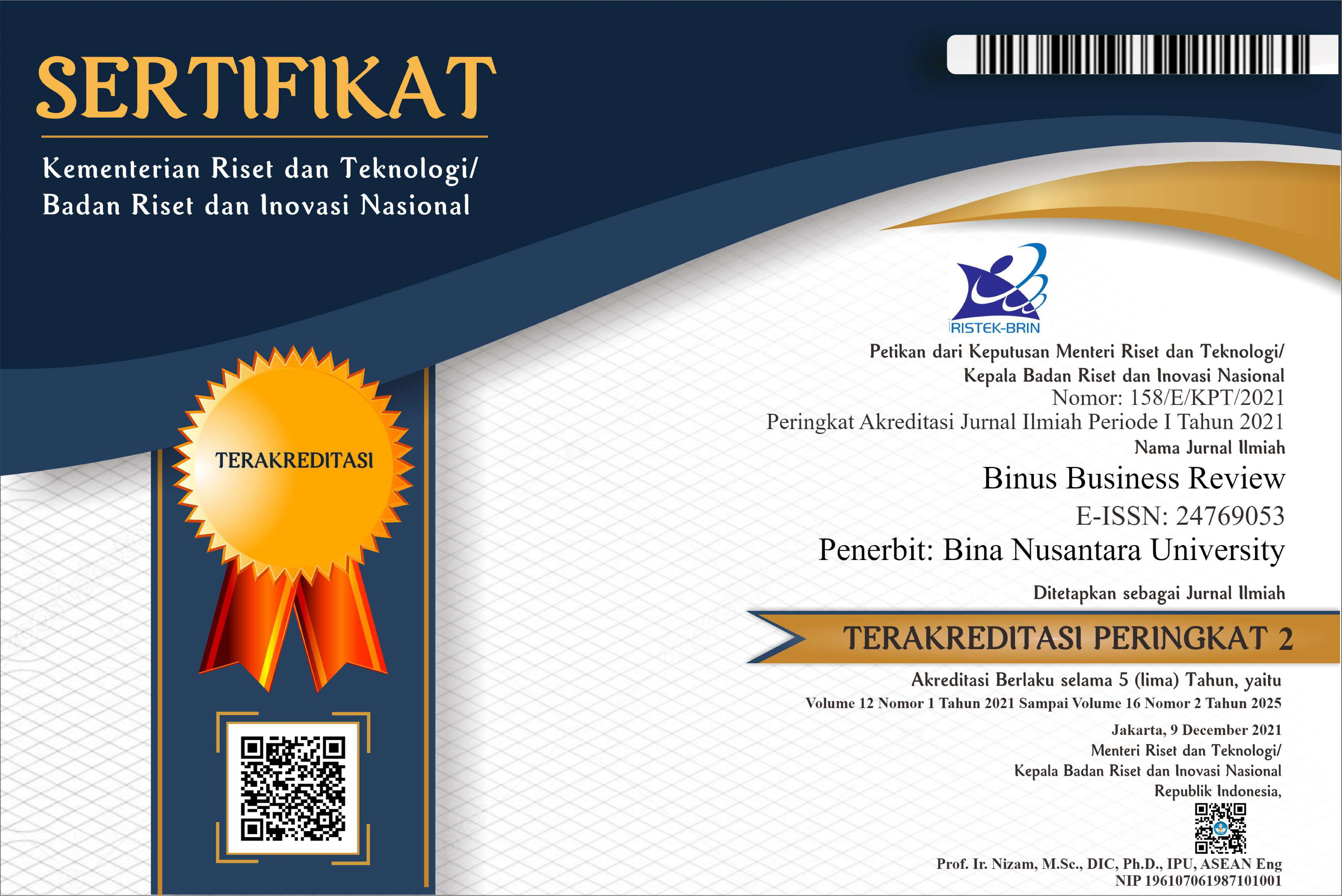Model Analisis Prediksi Kebangkrutan Bank Swasta Nasional Periode 2002-2006
DOI:
https://doi.org/10.21512/bbr.v3i2.1356Keywords:
Prediction Model of Bankruptcy, Altman, CAMEL, Multiple Discriminant AnalysisAbstract
There are two main objectives to be achieved by this study:to determine the accuracy level of prediction models of health national private banks using CAMEL ratios, and model the value of Z for the national private commercial banks by using multiple discriminant analysis (MDA) as well as Altman Z values on the model. Determination of the model using the Z value ratios banking health of Capital, Assets, Earnings and Liability (CAEL), then create a new Z value model specifically for national private commercial bank in Indonesia by using statistical analysis of MDA, with SPSS. The samples used were 30 banks, consisting of 19 survived banks in 2002 and 11 bankrupt banks in the same year. The results showed that the model value of Z in the year 2003-2006 cannot reach good accuracy when measured on a per year. Instead, the new Z value model generated by this study has better accuracy in predicting the rate of bankruptcy cases nationwide private commercial bank in Indonesia (86.7%) in 2002 and an average accuracy of 71.67% for the 4-year period of the review.Plum Analytics
References
______. (2000). Predicting Financial Distress of Companies: Revisiting the Z-Score and Zeta®
Models. New York.
Altman, E. I. (1968). Financial Ratios, Discriminant Analysis and the Prediction of Corporate
Bankruptcy. Amerika Serikat: Journal of Finance.
Bank Indonesia. 2002. Buku Direktori Perbankan Indonesia. Jakarta: Bank Indonesia
Bank Indonesia. 2003. Buku Direktori Perbankan Indonesia. Jakarta: Bank Indonesia
Bank Indonesia. 2004. Buku Direktori Perbankan Indonesia. Jakarta: Bank Indonesia
Bank Indonesia. 2005. Buku Direktori Perbankan Indonesia. Jakarta: Bank Indonesia
Bank Indonesia. 2006. Buku Direktori Perbankan Indonesia. Jakarta: Bank Indonesia
Brigham, E. F., dan Daves, P. R. (2004). Intermediate Financial Management: 8th Edition. AmerikaS
erikat: South Western-Thomson.
Chuvakin, N., dan Gertmenian, L. W. (2005). Predicting Bankruptcy in the WorldCom Age: How to
Determine When It Is Safe to Grant Credit. Amerika Serikat.
Daruri, A. D. (2007). Quo Vadis Arsitektur Perbankan Indonesia. Jakarta: Center For Banking Crisis.
Dendawijaya, L. (2005). Manajemen Perbankan. Bogor: Ghalia Indonesia.
Gautama, S. (2002). Indonesian Business Law. Bandung: PT Citra Aditya Bakti.
Hadad, M. D., Santoso, W., Sarwedi, H. S., dan Adenan, M. (2004). Model Prediksi Kepailitan Bank
Umum di Indonesia. Jakarta: Bank Indonesia.
Hair, J., Anderson, R. E., Tatham, R. L., dan Black, W. C. (1998). Multivariate Data Analysis: Fifth
Edition. New Jersey: Prentice Hall.
Hartono, J. (2004). Metodologi Penelitian Bisnis: Salah Kaprah dan Pengalaman-pengalaman.
Yogyakarta: BPFE.
Kusumastuti, R. (2001). A Study to Formulate a Bankruptcy Prediction Model for the Manufacturing
Industry in Indonesia. Yogyakarta: Universitas Gadjah Mada.
Muljono, T. P. (1995). Analisa Laporan Keuangan untuk Perbankan. Jakarta: Djambatan.
Nating, I. 2004. Kepailitan di Indonesia (Pengantar). Indonesia
Santoso, S. (2002). Buku Latihan SPSS Statistik Multivariat. Jakarta: Elex Media Komputindo.
Staf Investopedia.com. 2005. An Overview of Corporate Bankruptcy. Amerika Serikat.
www.bi.go.id
Downloads
Published
How to Cite
Issue
Section
License
Authors who publish with this journal agree to the following terms:
a. Authors retain copyright and grant the journal right of first publication with the work simultaneously licensed under a Creative Commons Attribution License - Share Alike that allows others to share the work with an acknowledgment of the work's authorship and initial publication in this journal.
b. Authors are able to enter into separate, additional contractual arrangements for the non-exclusive distribution of the journal's published version of the work (e.g., post it to an institutional repository or publish it in a book), with an acknowledgment of its initial publication in this journal.
c. Authors are permitted and encouraged to post their work online (e.g., in institutional repositories or on their website) prior to and during the submission process, as it can lead to productive exchanges, as well as earlier and greater citation of published work.
USER RIGHTS
All articles published Open Access will be immediately and permanently free for everyone to read and download. We are continuously working with our author communities to select the best choice of license options, currently being defined for this journal as follows: Creative Commons Attribution-Share Alike (CC BY-SA)




















